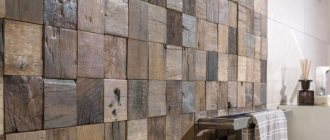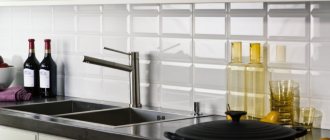How to find out. what color tile do you need?
Most likely, when you first bought tiles, you did not pay any attention to their tone. If you threw away all the boxes, then it is no longer possible to independently understand what tone the tiles had. The only way is to call the seller and, if a little time has passed since the purchase, ask what tone you got. The probability that he will answer you something intelligible is 15 percent. If you did not have time to throw out all the boxes, then you can find the tone on the box with the tiles.
Here is a photo of a box of Italian made tiles. We deliberately took a more complex case with a foreign box, since in Russian everything is written in Russian, and it is much easier to understand the meaning of what is written.
Let's look at box A in the photo. There are many different letters and numbers on it. How to understand what they mean? If you look closely, you will notice that on the box there are the words scelta (indicates variety in Italian), tono (tone), calibro (caliber), articolo (article) and codice (code). Ideally, under each word there should be a parameter corresponding to it, but in our case the inscription has moved, so the caliber is located under the tone, and the tone is between the tone and the grade. We drew red arrows on the picture so that we could see what belongs to what.
The box indicates that the box contains first grade tiles, tone D61, 7th gauge. In addition, the tile code 0070466, the name of the Life collection and the color name vela are indicated. You and I are still concerned about the tone. The tone of our tiles is D61 and this means that, in an amicable way, you need to purchase exactly the tone D61. If it is not there, you need to take the values as close as possible to it - D62, D60 and other D, and if there is no D, then the letters that are as close as possible to D are C or E. If there are none, then take the closest one to D61, what there is (not forgetting about the caliber, there will be a separate article on this topic soon).
Now we look at box B. The tiles in the box have tone A52 and caliber 7. That is, in terms of caliber it’s suitable, but in terms of tone it’s not very good.
The tile in box C has tone D61 and gauge 8. We were lucky with the tone - it is exactly the same as the original box A, so we feel free to buy more of it. (In this case, the difference in calibers of 1 mm can be neglected.)
Bottom line: if you have a choice, buy box C in addition to box A. If you have no choice, take what you have, after all, the difference between A and D is not that big.
Forms of paving slabs for paving:
Paving stones
Classic rectangular paving stones will enhance any area, be it a city sidewalk or a path in the garden. In the assortment of the Stellard plant it is presented in all colors and textures.
The dimensions of the paving stones are 200x100 mm in length and width, the thickness can be 40, 60 or 80 mm. The choice of tile thickness depends on the load on the paving area. For the installation schemes presented in this article, 60 mm tiles are used, which can be used for passenger car traffic.
Square 20x20
Square tiles measuring 200x200x60 mm are convenient for installation; they can be laid either independently or in combination with paving stones, thereby minimizing the cutting of outer stones.
Square 10x10
Square tiles measuring 100x100x60 in masonry can be used either independently or serve as a link between larger tiles (paving stones, 20x20 square, cap).
Black and white tiles in the interior
Metlakh floor tiles
Black and white colors will forever remain in the arsenal of designers. They were used for finishing rooms in a classical style, and are also used for the latest stylistic trends, which is explained by their respectability and high cost. On the other hand, they create an excellent background for highlighting bright design elements. This design is more common in the kitchen, bathroom and toilet.
Bathroom design
Successful predominance of a dark shade
In the bathroom, tiling does not end on the floor, but extends to the walls. A bathroom in contrasting colors looks elegant.
Here are some recommendations for decorating your bathroom in a fashionable and stylish way:
- A small bathroom should have white glossy tiles and a small amount of black so as not to cause a visual narrowing of the space.
- Equality of contrasting tones is preferable for large bathrooms.
- The bathroom should have a lot of lighting, so in addition to ceiling lamps, wall lamps are used. The geometric shapes of the lamps are simple. The chrome elements and golden hue combine perfectly.
- Displays of contrasting tones are present in plumbing fixtures. The tones of the sinks, bathtub and shower match the white tiles.
Kitchen
Interior of a light kitchen with dark countertops and a checkerboard floor
Lately, fewer and fewer homeowners are decorating their floors in black and white, much less using tiles in these tones for their walls. They think it's excessive and brings darkness.
In the center of the kitchen, place a decorative panel with a black pattern, which is mounted into a floor made of white tiles. Black tiles of smaller width are laid along the contour of the floor, creating the outline of the room. At the same time, it must be integral, not remain under the headset and other elements, and have an equal distance from the walls and furniture.
Toilet
The smallest room in the apartment, which requires careful selection of materials and design methods. White tiles with small splashes of smaller black tiles will do. To increase space, styling methods that contribute to this are used.
Design Tips
Based on the above, we can note several features of the harmonious and laconic design of premises in contrasting black and white tones:
Small rooms need to contain a lot of light. The lack of natural light is compensated by artificial sources
You can perform zoning with lighting using dim lamps. If the room is not very large, then the predominance of white over black should be felt. In spacious rooms, you can not focus on one of the tones. The placement of mirrors is important for the bathroom. They should reflect light areas of the cladding. Minimal use of dark colors is achieved with the help of ornaments. This way the interior looks more interesting, and there is no psychological overload.
It’s not for nothing that black and white are the “Yin-Yang” colors. They are in harmony with each other and fit succinctly into any interior.
Traditional tile and grout combination
Do not forget that the final appearance of the laid tiles is greatly influenced by the color of the grout. So, the interior will look especially stylish when a contrast of material and grout is created. For example, gray grout with white ceramic tiles will highlight the geometric pattern. A scheme for the color combination of tiles and grout is often provided by manufacturers who are themselves interested in obtaining beautiful interiors.
The rules for laying out tiles do not provide for any prohibition, some designers love experiments, in this photo, for example, a simple background tile is reinforced with real gold mosaics, it turned out beautifully
Where should this combination be used, in any interiors, but especially where only background tiles are used, without decors.
Schemes for laying tiles on the floor
Floor tiles are laid only in horizontal rows. Each middle of the elements from the next strip should lie on the junction of the square from the previous row. To achieve real aesthetic pleasure from the result, offset laying must be done with strict adherence to the thickness of the seams. In the corridor or on the terrace, diagonal masonry will look original.
In this case, the tiles are distributed on the surface at an angle of 45 degrees relative to the wall. Before you start laying tiles, you must determine the floor level.
To do this, lay lighthouse slabs in the corners and make a screed. If necessary, level the tiles using a rubber hammer.
Rectangular elements of various lengths are suitable for work. The method is quite complicated to implement, but the end result will surprise you with its originality. The first will externally resemble parquet; for the second, mosaic inserts or cut pieces of elements of a different color will be additionally used. By choosing the right pattern, you can make a durable tiled floor that imitates the pattern of laminate or parquet.
On old tiles. On floors made of chipboard or similar materials.
This method is used to decorate irregularly shaped rooms, since the pattern creates an optical illusion and smoothes out the difference in the size of the room. The laying pattern can be single - each new tile touches the adjacent one, double - there are two rectangular tiles in a row, triple - resembles weaving, each row consists of 3 fragments. Arranging the parts diagonally on the floor not only creates a stunning pattern, but also minimizes waste during work.
A simple method is the best option for training in working with floor tiles. A design made from several modules of different sizes looks interesting and original.
It will look great in small rooms. First of all, the installation scheme, module size and pattern are selected. When creating a drawing, it is important to take into account the thickness of the seams, otherwise the entire work will be ruined. To simplify the task, you can immediately purchase a set of tiles with a ready-made map for a certain quadrature. The basic principle of the modular laying method is a repeatedly repeating heterogeneous pattern.
Herringbone tile layout
In a herringbone layout, the material is laid at right angles in the form of zigzags, similar to parquet. Herringbone is used for both walls and floors. This type of installation is a complex option, but creates an attractive interior using simple material. There is no need to use decors, and using only background tiles significantly reduces the cost of the project. There may be a slight increase in material waste during installation.
Tip: Herringbone laying is best used to accent walls, looks very impressive on large surfaces, and is suitable for laying in the kitchen, bathroom or in an area of the house where you need to make a strong accent on the finish.
The angular nature of this pattern creates a dynamic energy that can be ideal for accent walls, but a little overwhelming if too large a surface is used. The layout of the tiles is carried out as follows: first, a separate module is formed, then it is simply copied and trimmed along the edges of the floor or wall.
The photo shows a project for such a tile layout.











